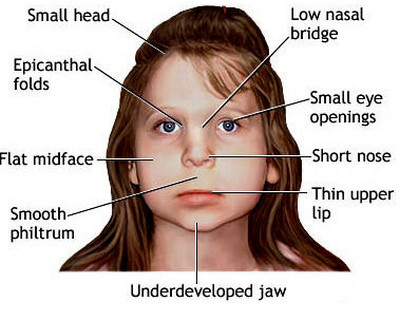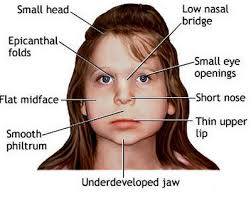
Related Autism conditions
Autism is often diagnosed alongside other conditions. It’s important to support people with more than one condition in a way that meets all their needs, while understanding that the needs arising from autism are distinct.

Fetal Alcohol Spectrum Disorder
Fetal alcohol spectrum disorders (FASDs) are a group of conditions that can occur in a person whose mother drank alcohol during pregnancy. Problems may include an abnormal appearance, short height, low body weight, small head size, poor coordination, low intelligence, behavior problems, and problems with hearing or seeing.Those affected are more likely to have trouble in school, legal problems, participate in high-risk behaviors, and have trouble with alcohol or other drugs.
ADHD (Attention Deficit Hyperactivity Disorder)
Most people with ADHD have difficulty with both inattentiveness and hyperactivity-impulsivity. For some people with ADHD, their difficulties mainly lie in just one of these two areas. ADHD has an impact on day-to-day life, including school, work and relationships. ADHD tends to run in families, and most children who are diagnosed get the diagnosis between the ages of 6 and 12. There can be confusion about the links between ADHD and autism.
Find out more at ADDISS, YoungMinds, The ADHD Foundation and ADDUK (a site by and for adults with ADHD).
Hearing impairment
Hearing impairment causes problems in hearing other people and things. The NHS offers hearing screening for all newborn babies in their first few weeks. Early diagnosis increases their chances of good communication and language development. Some people with ASDs have sensory processing difficulties. If you or the person you are caring for is sensitive to noise, arrange a hearing test through your GP. Professionals who specialize in ASD and hearing impairment do not always agree on the best approaches. But many professionals have found that when parents teach their child sign language at an early stage, it can help them to communicate and assist their learning as they grow up. Some communication approaches to try include: visual supports, objects of reference, Sign Language and Makaton.
Down’s syndrome
Down’s syndrome is a lifelong condition that causes delays in learning and development. It cannot be cured, but people with the condition can be supported to live a happy and independent life. Most parents find out that their baby has Down’s syndrome soon after their birth. It occurs because some babies’ cells contain an extra chromosome 21. All people with Down’s syndrome will have some degree of learning disability. Children with Down’s syndrome do learn to walk, talk and be toilet trained but in general will meet these developmental milestones later than children who do not have Down’s syndrome. They may find it easier to learn visually, like many people with autism, and learn to talk more easily if the main words are signed as well as spoken. Some people have a dual diagnosis of Down’s syndrome and autism.
Dyslexia
Dyslexia is a lifelong specific learning difficulty which mainly affects the development of literacy and language related skills. It affects the way information is processed, stored and retrieved, with problems of memory, speed of processing, time perception, organization and sequencing.
Dyspraxia
Dyspraxia is thought to be caused by the way that the brain processes information, which results in messages not being properly or fully transmitted. It affects the planning of what to do and how to do it, and is associated with problems of perception, language and thought. Dyspraxia sometimes runs in families. People with autism often have difficulties with motor co-ordination and, if they are significantly affected in this way, may also be given a formal diagnosis of dyspraxia. As with autism, people with dyspraxia may be over- or under-sensitive to certain sensory stimuli.
Epilepsy
Epilepsy is a condition in which a person has recurrent seizures due to an imbalance in brain chemistry. One in 103 people has epilepsy. Many types of seizure can occur and epilepsy can affect anyone at any age. People who are on the autism spectrum are more likely to have epilepsy than people who aren’t. People who have epilepsy are more likely to be on the autism spectrum than those without epilepsy. One does not cause the other. People with autism and intellectual disability are more likely to develop epilepsy than others on the spectrum. Some behaviors associated with autism can look like seizures, that is, staring or repetitive movements. Any concerns should be explored by a specialist.
Fetal anti-convulsant syndrome (FACS)
Fetal anti-convulsant syndrome (FACS) can occur when a woman takes epilepsy medications (anti-convulsants) during pregnancy. Not every child who is exposed to these medicines will have FACS. A child with FACS may have a delay in developing speech and language or may have difficulties with social interaction, memory and attention. Some may also have other conditions, such as spina bifida. A number of children with FACS also have a diagnosis of autism.
Fragile X syndrome
Fragile X Syndrome is the most common known cause of inherited learning disability, affecting one in 4,000 men or boys and one in 6,000 women or girls. People with Fragile X can have mild to severe learning disabilities. Their speech and language development may be delayed and they can experience anxiety in social situations. Behaviors associated with Fragile X can include a short attention span, impulsiveness, over activity, dislike of eye contact, difficulty in relating to other people, the need for a familiar routine, repetitive speech and hand flapping or hand biting. Some of these are similar to difficulties that people with autism may experience. However, autism and Fragile X syndrome are two different diagnoses.
Hyperlexia
Hyperlexia is characterised by an intense fascination with letters or numbers or, in younger people, an ability to read far beyond their age. People with hyperlexia may, nevertheless, have difficulty understanding verbal language and interacting and socialising with others. Find out more at Hyperlexia UK.
Learning disabilities
People with autism can have different ‘degrees’ of learning disability, which can affect all aspects of their life, from studying in school to learning how to wash themselves or make a meal. Some people will be able to live fairly independently – although they may need a degree of support to achieve this – while others may require lifelong, specialist support. People with a diagnosis of Asperger syndrome do not usually have accompanying learning disabilities, but may still have specific learning difficulties, such as dyslexia.
Social Communication Disorder
This diagnosis might be given where someone exhibits the social communication and interaction aspects of autism, but does not show restricted, repetitive patterns of behavior, interests or activities.
A person with social communication disorder will have difficulties with verbal and non-verbal communication that cannot be explained by low cognitive ability, will have difficulties in learning and using spoken and written language, and will give inappropriate responses in conversation. Social relationships, academic achievement and occupational performance can be affected. Some people with these characteristics may have been given a diagnosis of Semantic Pragmatic Disorder or Pragmatic Language Impairment.
Visual impairment
Visual impairment is ‘a profound permanent reduction or absence of vision that cannot be corrected with spectacles or contact lenses’. A child may be found to have a visual impairment in the first few months of life, before it is possible to diagnose an ASD; start life sighted but later lose their sight; or lose their sight through self-injury. There are no published tools for diagnosing ASD in visually impaired people. We do not know how many people have both visual impairment and an ASD. Visual impairment itself is low incidence, so visual impairment and ASD must be very low incidence. However, for the people concerned, for their families and for the practitioners working with them, the impact is very high. When visual impairment and ASD occur together, it is not a question of simply adding together the impact of the two disabilities – the impact is much greater because the difficulties arising from each disability interact with each other. People who have both a visual impairment and an ASD will all have individual characteristics, abilities and needs. Commonly-used approaches will not always be suitable.
